IN THIS ISSUE
- Remembering a revered botanist
- How to band 2,000 terns, and why
- Plant network lands another award
- Eva Persons' impact on conservation
- Also: rare birds, lampreys, skunks and fyke nets
 Georgia’s hummingbird license plate is about to fly away.
In its place will be a new pollinator-themed plate! That vibrant design, available starting next month at county tag offices and online, will feature a Georgia aster – both a striking wildflower and a species of conservation concern – and a monarch butterfly, an iconic insect being considered for Endangered Species Act listing.
The soon-coming plate is a great way to show your support for conserving native plants, pollinators and other wildlife that depend on them. Department of Natural Resources wildlife plates are a top source of revenue for the agency's Wildlife Conservation Section, which leads this work and depends largely on fundraisers.
However, if you’ve been thinking about adding a vintage hummer tag to your car, this is your last chance.
The ruby-throat design will be retired Aug. 31. (Of course, vehicle owners who already have a hummer plate can keep and renew them each year.)
Top
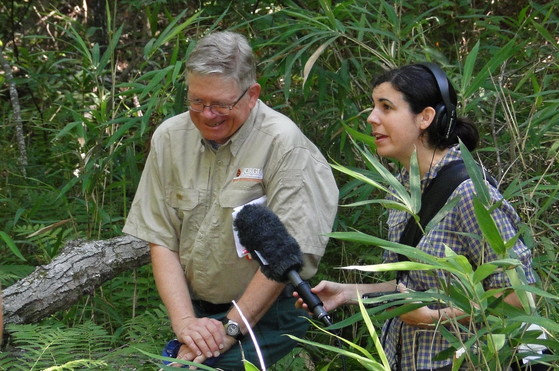 DNR's Tom Patrick discusses monkeyface orchids with WABE-FM reporter Molly Samuel (Rick Lavender/DNR)
The conservation community is mourning the loss of DNR botanist Tom Patrick.
Patrick, of Monticello, died Aug. 22. He was the agency’s first botanist, joining in 1986 what was then the Georgia Natural Heritage Inventory Program, an initiative of DNR and The Nature Conservancy ("Heritage turns 25," November 2011).
Patrick was noted for his knowledge of native flora – he authored “Protected Plants of Georgia,” a botanical standard – and his ready but respectful willingness to share that knowledge with others. In this 2011 video, he explained the importance of blackland prairies at Oaky Woods Wildlife Management Area near Perry.
This spring, before the Georgia Plant Conservation Alliance presented its first lifetime achievement award to Patrick – an award named after him – the medal was passed around the room in a “warming ceremony” that allowed each member to hold and honor the award Patrick would soon receive (“GPCA honors plant champ,” June 20). The medal was engraved with a persistent trillium, a species endemic to Georgia and befitting Patrick’s expertise in and fondness for the genus trillium.
It's also fitting that "persistent" epitomized his approach and commitment to conserving native plants.
Patrick is survived by his wife Bretta, two sons and other family.
Top
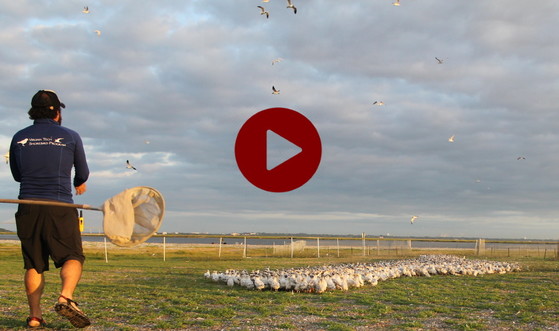 Herding tern chicks for banding on the Brunswick dredge island (Tim Keyes/DNR)
How do you band 2,000 tern chicks in two days?
With a good plan, plenty of help and a healthy appreciation for the purpose behind the chaos.
On two mornings in July, DNR and Virginia Tech staff and volunteers herded mobs of squawking, stumbling royal and sandwich tern chicks into temporary corrals on the Brunswick dredge island as anxious parents wheeled and trilled overhead.
Weeks later, most of the chicks are flying and many have been spotted, ID’d by their new plastic leg bands, DNR wildlife biologist Tim Keyes said.
“We are getting band resights from those chicks all up and down the coast, from Tybee, Sapelo, the Altamaha delta, Cumberland, northeast Florida. It’s pretty cool.”
It’s also what project leaders hoped for. The banding is part of a Virginia Tech study focused on Virginia’s largest colony for colonial seabirds, a man-made island in Chesapeake Bay where as many as 20,000 royal terns and other birds nest. A $3.8 billion expansion of the Hampton Roads Bridge-Tunnel to ease traffic congestion will remove nesting habitat on the island.
Scientists documenting how seabirds use the site want to see where the displaced terns wind up. The Brunswick island, between St. Simons and Jekyll islands, is protected habitat that will serve as something of a control area.
Keyes said the study also will provide data to better estimate how many terns nest on the island, how many young they produce and – by tracking the birds, from Maine to Peru – how vital the colony is.
Considering the immediate results, so far, so good.
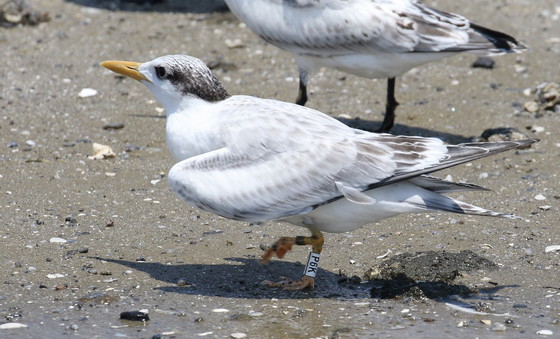 Young royal tern with a new leg band (Tim Keyes/DNR)
REPORT SIGHTINGS
To report a sighting, email the band code, time and place to vt.plover@gmail.com. Good photos are welcomed. At the Brunswick dredge island, 1,500 royal tern chicks received plastic bands. About another 500 royal and sandwich tern chicks received metal leg bands (which are less easy to read in the field).
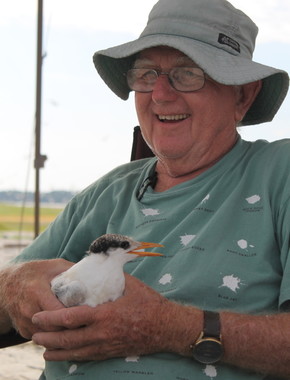
BRINGING UP TERNS
The young of crested terns – including royal and sandwich terns – leave the nest, or scrape, within a day after hatching, forming a large group of chicks called a creche (nursery).
One benefit of this behavior is that fewer adults can watch over more young, freeing other adults to forage for food -- even miles away.
Cued by sound and sight, parents apparently have no problem picking out their offspring in a sea of chicks.
DNR's Tim Keyes said that during the banding, when the chicks were in corrals, adults quickly found and fed their young.
At right: Volunteer Gene Keferl holds a tern for banding (Susan Inman/Altamaha Riverkeeper)
|
Top
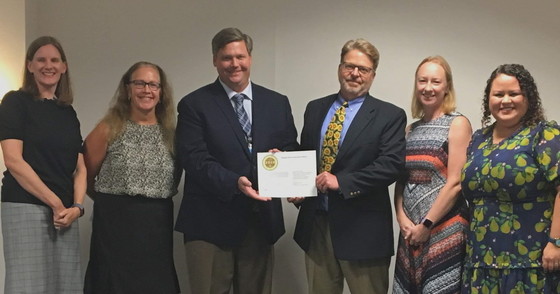 DOT's David Hedeen, left, and DNR's Dr. J. Mincy Moffett Jr. accept the award from Federal Highway Administration officials (Angela Berthaume/Volpe Center)
The Georgia Plant Conservation Alliance continues to rack up national awards.
In May, it was an honorable mention in environmental excellence from the National Association of Environmental Professionals.
This month, it was a 2019 Environmental Excellence Award from the Federal Highway Administration. The prestigious honor recognized the Georgia Department of Transportation's 20-year-plus partnership with the GPCA to restore habitats, safeguard rare plants and address invasive species.
Formed in 1995, GPCA is a network of botanical gardens and arboreta, agencies -- including DNR -- non-profits, universities and companies that share knowledge, data, equipment, volunteers and labor for one primary cause: conserving Georgia’s rare plants.
As the awards attest, the alliance is working.
Top
 This segment of Georgia Wild is usually where we answer your questions.
But we’re flipping the script this month for our annual readers survey.
Give us your thoughts about the newsletter and we'll put your name in the hat for a DNR cap.
It’s easy. Take this brief survey. Add your email at the end and you will be entered in a drawing for a Wildlife Resources Division hat (sorry, treefrog not included).
Complete the survey by midnight Sept. 5. We will notify the 10 winners by Sept. 12.
What are you waiting for?
Top
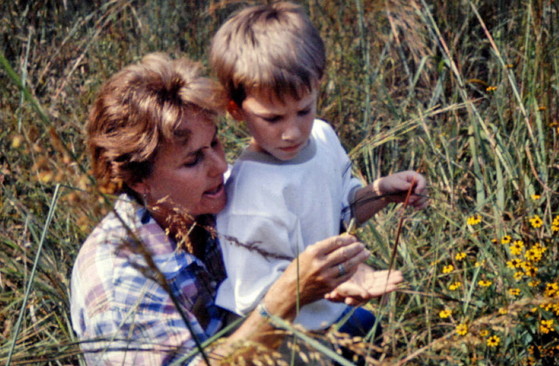 An outdoors memory: Eva Persons talks wildlife with young Ben Granitz (Jim Couch/DNR)
By TERRY W. JOHNSON
On a hot summer day in 1990, as dignitaries gathered to dedicate the office of Georgia’s fledgling Nongame-Endangered Wildlife Program, I overheard one say to the person beside him, "I give the program three years before it folds."
Fortunately, the prediction proved wrong. That program is now the Wildlife Conservation Section. The staff has grown from one biologist to more than 100 employees. The result: DNR is better able than ever to conserve Georgia's nongame wildlife and plants.
Yet while many played key roles in this story, the success is due in large part to the efforts of a dedicated conservationist from Monroe County, Eva Persons. ...
Read the rest of Terry’s column to learn about Eva's impact on wildlife.
Terry W. Johnson is a retired DNR program manager and executive director of TERN, friends group of DNR's Wildlife Conservation Section. Explore his columns, his Backyard Wildlife Connection blog and his latest book “A Journey of Discovery: Monroe County Outdoors.” (Permission is required to reprint this column.)
Top
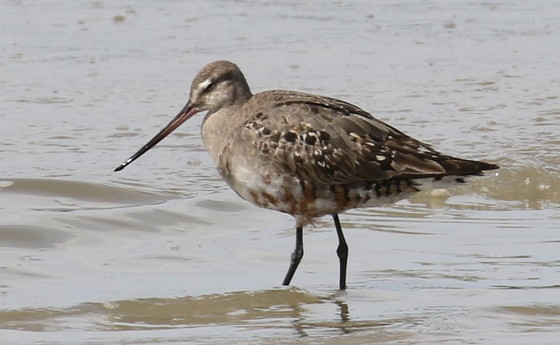 A Georgia-rare Hudsonian godwit seen on St. Catherines Bar (Tim Keyes/DNR)
During International Shorebird Surveys this month, DNR biologist Tim Keyes spotted not one but two rare birds near St. Catherines Island. On Aug. 7 on Oldnor Island, he reported what will likely be Georgia’s first confirmed European whimbrel, a subspecies native to Eurasia and marked by white on its lower back and rump. On Aug. 20 at St. Catherines Bar, it was a Hudsonian godwit, possibly only the state’s sixth record of these marathon migrants that fly nonstop in late-summer from northeastern North America to South America.
What looked like a case of plant poaching in northeast Georgia proved to be an example of a non-native animal affecting an at-risk native species. Federal and state botanists investigating the disappearance of endangered smooth purple coneflowers from a Chattahoochee National Forest stand said evidence related to the digging and other damage pointed to armadillos, not people, as the culprit.
Not only have loggerhead sea turtles shattered their nesting record for the state – more than 3,910 nests compared to the previous high of 3,289 – hatching is going strong. More than 194,000 hatchlings have emerged, a mean emergence rate of 68 percent, according to the Georgia Sea Turtle Cooperative.
Top
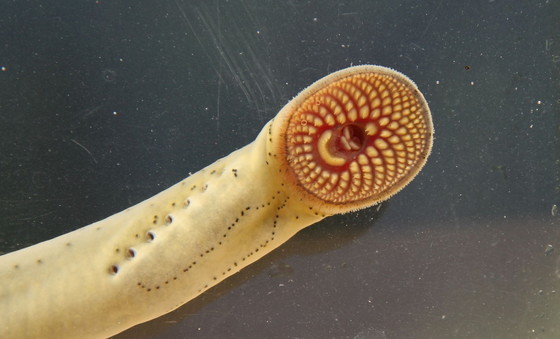 Open wide: a chestnut lamprey up close (Brett Albanese/DNR)
While it might look alien, the chestnut lamprey is one of several species of this primitive fish that is native to Georgia. While most are non-parasitic filter-feeders, the chestnut lamprey does have a parasitic stage in which it uses its suction cup-like mouth to attach to other fish – although, overall, lampreys are a natural part of the state’s river ecosystems and do not negatively affect fish populations.
A survey for rare wildlife on a Wayne County tract turned up a surprise: more than 160 hairy rattleweed plants. The endangered species is known worldwide only from Wayne and Brantley counties, and DNR and the Natural Resources Conservation Service will work with the landowner to protect the newly discovered population.
Prescribed fires covering nearly 500 acres last month at Sandhills Wildlife Management Area East and adjacent lands near Butler were timed to avoid gopher frog migrations from ephemeral wetlands where the rare frogs breed. Guided by research including UGA- and DNR-run camera traps, syncing burns to herpetofauna movements is seen as a significant plus for conserving amphibians.
Top
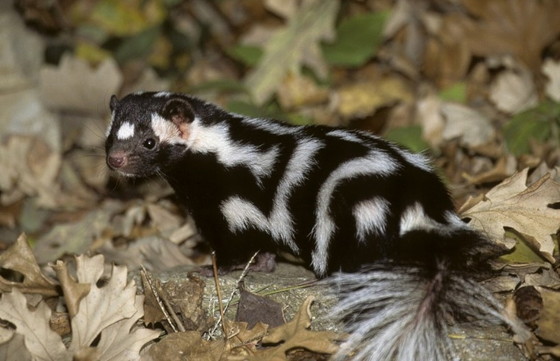 The search is on in Georgia for eastern spotted skunks (Bob Gress)
Seen me? DNR wants to learn more about the distribution and status of eastern spotted skunks in Georgia, meaning hunters and others who spot these elusive creatures – cousins to the more common striped skunk – can help by reporting sightings and providing images, trail cam videos and other details.
The 30th annual Give Wildlife a Chance Poster Contest is turning the attention of Georgia’s K-5 students and teachers to bogs, “unique wetlands for rare species.” The popular competition sponsored by DNR, the State Botanical Garden of Georgia and TERN, friends group of DNR’s Wildlife Conservation Section, is aimed at increasing knowledge and appreciation of Georgia’s diverse wildlife and their habitats. Contest details.
An acoustic survey for rare robust redhorse in the Savannah River near Girard recently detected two of the fish. Since May, researchers have documented eight of 11 tagged robust redhorse in that reach of the river, a spawning area for the species.
Top
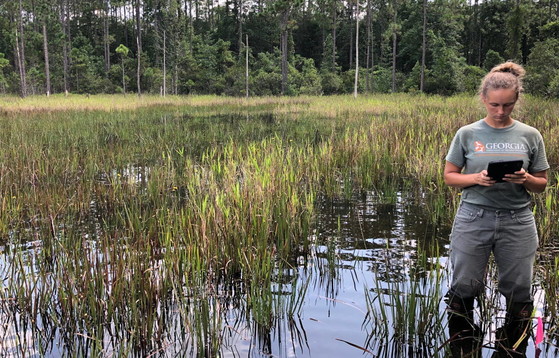 DNR's Melanie Flood assesses wetland vegetation for monitoring (DNR)
Work by DNR botany crews to monitor habitat restoration at ponds on Townsend Wildlife Management Area and another key south Georgia conservation site is hot, buggy and tiring, anything but glamorous. But the payoff is rich: Researchers will better understand how changes such as reducing dense woody brush and increasing the grassy cover benefit rare amphibians.
Squirrel season is open and more hunting seasons will be soon. Brush up on dates and regulations, and remember that buying a hunting license returns to Georgia wildlife management up to $45 in federal excise taxes paid on firearms, ammo and archery equipment.
Pine Lake in DeKalb County has been recognized as an Atlanta Audubon Certified Wildlife Sanctuary. The area, new to the program that encourages enhancing private and public land for birds and other wildlife, has a 17-acre lake, park, adjoining wetlands and a bio-retention area.
Names in the news: Cpl. Quinn Fogle of southwest Georgia’s Early County has been named DNR’s 2019 Game Warden of the Year. Fogle, whose 422 citations, warnings and assists combined more than tripled the region average, also landed two other awards at the Game Warden Awards Banquet in Savannah: Investigative Game Warden of the Year and Georgia Boating Officer of the Year. Game Warden 1st Class Patrick Gibbs, assigned to Evans County in southeast Georgia, received the James R. Darnell Award as Warden of the Year runner-up and the Rocky Wainwright Waterfowl Award for his work enforcing waterfowl hunting laws. DNR senior wildlife biologist Matthew Rowe co-taught the annual Apalachicola-Chattahoochee-Flint Freshwater Mussel Workshop held at the Joseph W. Jones Ecological Research Center near Albany. The workshop was started in 2005 to help state and federal staff, students, consultants, and others familiarize themselves with the basin's diverse and sometimes cryptic freshwater mussels. DNR’s Marylou Moore was featured in a Vidalia Advance Community Living cover article highlighting the conservation of rare species and the Interagency Burn Team.
UPCOMING
Sept. 25 -- Georgia Prescribed Fire Council annual meeting, UGA Tifton Campus Conference Center, Tifton
Sept. 28 -- National Hunting and Fishing Day (free fishing -- no license required -- for Georgia residents)
Oct. 5 -- CoastFest 2019, 10 a.m.-4 p.m., Mary Ross Waterfront Park, Brunswick
Nov. 1-3 -- Becoming an Outdoors-woman Workshop, Charlie Elliott Wildlife Center, Mansfield
March 2-6 -- Southeastern Partners in Plant Conservation symposium and workshop, Southeastern Center for Conservation, Atlanta Botanical Garden
WHAT YOU MISSED ...
In the previous Georgia Wild:
- Tracking a pine snake
- Inside the pilot whale rescue
- The fly carpenter bees fear
- Mega-mom helps set sea turtle record
Top
"A record-breaking summer for Georgia’s sea turtles," WABE-FM (90.1, Atlanta)
"DNR sponsors 30th annual K-5 art competition," WNEG-FM (93.1, Toccoa)
"DOT sign on Tybee highway urges awareness of terrapins," Bluffton Today
"Interns arrive to tackle invasive plants," The Brunswick News
"Officers stake out airports, nab accused turtle trafficker," The Associated Press
"Georgia transportation department wins national award," Valdosta Daily Times
(+video) "How do monarchs know when to migrate?" EarthSky. Published study.
"Can Janisse Ray make us care enough to save Georgia's forests?" Atlanta
"Wildlife Federation hires UGA R3 coordinator," The (Rockdale/Newton) Citizen
"Prescribed fire important tool in landscapes," (Dalton) Daily Citizen-News
"Chehaw's Kirkland presented Jim Fowler Award," The Albany Herald
"Bird rookery protected as part of St. Marks NWR," U.S. Fish and Wildlife Service
"Climate change: Make that 18 months (to save the planet)," BBC
Top
 A loggerhead hatchling reaches the surf on Ossabaw Island (Caleigh Quick/DNR)
VIDEO
For this issue, we're featuring DNR vids of sea turtle nesting and monitoring.
Daylight sea turtle nest boil (hatching) on Ossabaw Island
Nighttime boil
Releasing a young Kemp's ridley accidentally hooked by a recreational angler
A four-legged Ossabaw road block
Top
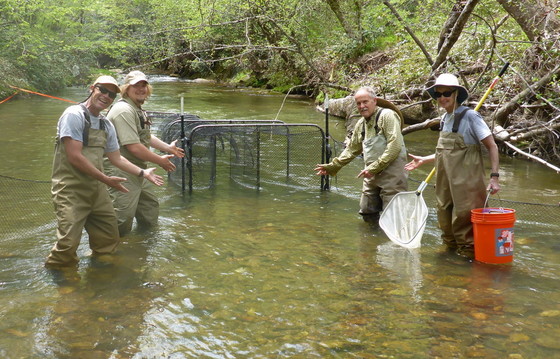 A fyke net, complete with welcoming committee (Brett Albanese/DNR)
Angling is the most popular way to catch fish. But when DNR’s Wildlife Conservation Section studies fish communities or the biology of rare species, hook-and-line isn’t the preferred method. Instead, scientists often bank on fyke nets, which mimic the weirs American Indians used to catch fish. Learn more in this blog post. Also check out this video of a fyke net full of sicklefin redhorse.
The sicklefin redhorse is state-protected as endangered. Even more, this species has its own T-shirt, which according to the Sicklefin Redhorse Conservation Committee is as cool as Johnny Cash. Sales will benefit conservation through the Hiawassee River Watershed Coalition, which recently merged with Mountain True.
CREDITS
Masthead: Aerial view of royal terns nesting on the Brunswick dredge island (Tim Keyes/DNR)
Top
|